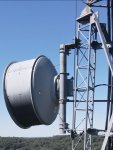- Joined
- Dec 22, 2005
- Messages
- 1,789
Can you help me understand some of the reasons 11GHZ might be chosen for backhauls of a P25 TRS.
The reading I have done so far leads me to conclude that 11GHZ and up can suffer from rain fade. That is exactly what I am seeing, especially with thunderstorm cell penetration along the path.
Why choose 11 over some of the lower bands? TIA!
The reading I have done so far leads me to conclude that 11GHZ and up can suffer from rain fade. That is exactly what I am seeing, especially with thunderstorm cell penetration along the path.
Why choose 11 over some of the lower bands? TIA!


